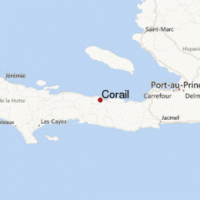Corail

The town of Corail was founded in 1660. Its date of elevation to the rank of municipality is not known. It has five communal sections. The town and the third communal section are coastal, the rest of the commune is inland. Depending on where the area is located in the commune, the relief is either plain or plateau or mountainous. The climate also varies depending on where you are in the commune. Its inhabitants are called Coraillais. in 1998, the total population of the commune of Corail was estimated at 26 808 inhabitants with a density of 128 inhabitants/km2. In the year 2004 this population will be able to reach nearly 29 000 inhabitants with a density of nearly 137 inhabitants/km2. The surface of the commune of coral is 209.95 km2.
After the earthquake that took place in 2010, there was rapid growth in the population as people in thousands, trotted into Corail. In Haiti, it is known as the only ‘official camp’ which has been set up in April 2010, thanks to the Haiti government.
A lot of planning was involved in Corail’s camp construction. However a large number of NGOs or non-governmental organizations provided aid with trouble rooms and clean latrines and water in the camp.
In the formation of the camp, a fundamental role was played by Oxfam International. To set up showers, toilets and water bladders, around 200 people from Haiti were hired. Planning was not done by the government to control the number of people in the camp. Hence the number of people at the camp kept increasing which led to steady falling of living conditions in Corail.
Education: The Ministry of the National Education for Youth and Sports is represented by a school inspection office in the commune of Corail. There were kindergarten, primary schools including five public, several private and three congregational schools. At the secondary level, she has two secondary schools (one public and the other private). There is no technical and vocational school, no university or other higher education in the commune.
Health: The Ministry of Public Health and Population is not represented in the municipality, it has on the other hand a hospital and a clinic with two Doctors, three nurses, an auxiliary and thirty-one certified matrons.
Utilities: With regard to water resources, the commune of Coral has three rivers, thirty springs, eleven Ponds, three lagoons and four public fountains. It is electrified by a private company (Imagine) and the frequency of electrical power supply is 23 hours per week.
Security: At the level of administrative and judicial infrastructure The municipality has a police station and a peace court, there is no prison.
Religion: The municipality has fourteen Catholic churches (including chapels), six Baptist churches, two Adventist Churches, seven Pentecostal churches, three churches of God and a Methodist Church.
Communication: The telephone and postal service and the print and television press do not exist in the municipality. There are, however, two radio stations.
Leisure: A cinema room, six plots (free spaces for the practice of football {soccer}), two night clubs, nine Gaguères and a public square. For cultural heritages, the commune has a waterfall and a cave. It has no notorious places or temples, but a large number of Hougans and Mambos have been listed in the commune.

